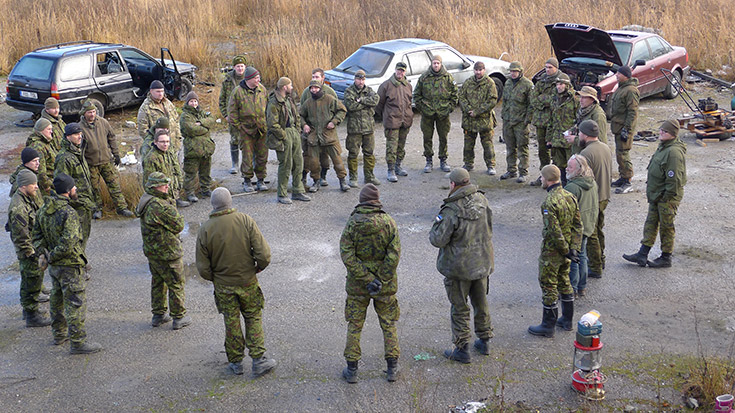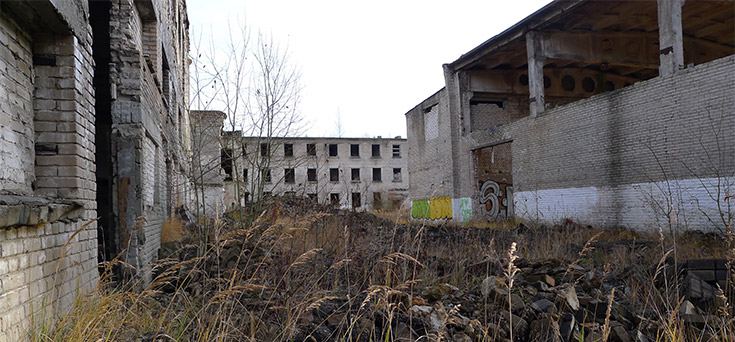Urban survival training in Estonia
For several years, Christo Motz has been organising pilot projects on urban survival for citizens and policymakers with the fire service and the Ministry of Security and Justice in the Netherlands. More recently, he took part in an urban survival training course in a disused Soviet Military camp in Estonia, which he describes in this blog

Before dawn on November 13, Kristjan and I left for Pärnu, where we were picked up by one of his friends. In an old former Dutch army all-terrain Mercedes we drove on brand new asphalt roads through forests, along sprawling estates interspersed by the occasional farm.
After a two-hour drive, we arrived in Rummu, a former Soviet prison camp, where we were to take part in a three-day SERE Urban Survival Training.
The training site included a number of derelict administrative offices surrounded by mounds of rubble and waste of dubious origin; pieces of asbestos and chemical vats lay exposed throughout the area.
Metres-high piles of bricks of collapsed walls with iron construction strips sticking out, buildings on the verge of collapse and sinister, empty, factory halls completed the image of havoc and devastation. This immense complex borders the former prison camp, which is surrounded by razor wire fences that are several metres high, and guard towers you can ascend via spiral staircases to obtain a view of the terrain. Once thousands of prisoners were held here. The Russian system was organised in such a way that food and supplies were delivered at a drop-off point in the camp. Structural shortages were artificially created. Russian soldiers guarded the periphery with a ‘licence to kill’. Within the walls the prisoners were forced to make their own rules. It is difficult to contemplate the terror and misery that these conditions must have led to.
Once everyone had arrived, there was a briefing at the assembly point led by Erki Vaikre, as Head of Survival who, together with his team, was responsible for organising this training. As a Dutch person I was placed in a team with two Estonians, three Danes and a South African, the latter four being members of a Danish reconnaissance unit. In total over 30 military and five instructors took part in the training.
Shelter
We were split into four groups and each team was assigned an empty building. We took up residence in building number four, in two rooms on the ground floor with a view of building three, separated by a derelict wall.
The background scenario was that Russian troops had invaded Estonia. Our unit had retreated to an urban area that had been completely destroyed. This was not tactical training; there was no urban combat, as that calls for a different approach. The primary goals were to co-operate, improvise and learn to make use of available materials.
In a military conflict or natural disaster, critical infrastructure will often collapse quite quickly. Our society is dependent on a well-functioning electricity network to preserve food, water purification, heating and lighting, (emergency) communication, maintaining law and order, health care, logistics and transport. It is crucial for individuals, family members and community members to be prepared in case of a black-out/ power outage.
The first assignment was to chart our immediate surroundings by making a sketch of the area. After an hour, one man from each team went to the assembly point to make a joint map of the training site. The motto is: “Know where you are and how to escape”.

In an urban environment there is usually no lack of materials. Each team was assigned a scrap car with a number of tools such as a hammer and saw. They also received a parcel of food containing turkey, bass, salmon and dough. There were three oil drums for communal use, which meant one team did not get one – as it happens it was our team that missed out.
There were aluminium chimneys, pallets, construction wood and various sizes of nails. It was essential that each team took the other teams into account – chances of survival are greatly increased if people co-operate.
There were a number of unstable facing walls and missing stairwells in building 4. Setting up camp on the first floor was not an option as it was dangerous in the evening and at night. The space downstairs as small and clear of clutter with only a doorway and a hole where once there was a window and that now needs to be closed off.
Since we did not have an oil drum, together with Brian and one of the Estonians, I built a heater out of bricks, others prepared mortar and we tacked a plastic tarp across the window. When evening fell, we had a pretty good heater with a chimney leading out. At first the room filled up with smoke because the aluminium chimney pipes were leaking, but we managed to fix it using fire retardant insulation material and wire.
It was important to create a habitable place which was easy to keep warm, where food could be prepared and where it was possible to practice basic hygiene is possible. Hygiene and preventative health care were therefore at the top of the priority list. Everyone has to maintain minimal bodily hygiene, and wash their hands after using the bathroom. This is especially true if there is a shortage of clean drinking water and soap. In this environment it is easy to get injured or hurt. Contagious diseases can take hold in no time at all, transmitted via fleas, lice and other vermin that thrive on dirty clothes and dirty surroundings. In tactical situations this problem would be even greater.
Adapting
Exhaustion and stress are common afflictions for humans in emergency situations. When all material security falls away this causes fear and possibly even blind panic. By adapting in the ‘cold phase’ to (fast) changing circumstances, you learn to keep your head cool and your heart warm, enabling you to handle unexpected situations flexibly and proactively. Sometimes it is best to do nothing and observe what is happening within yourself and your surroundings. The more you are in tune with your inner self, the stronger your intuition, and the better you will be able to recognise warning signals in time.
Our group functioned perfectly. Everyone did what they could; the challenges were clear; we had to be very alert as it was dangerous terrain. The discomfort, lack of sleep, and intense co-operation provided plenty to discuss. Everyone had a practical approach; difficulties were there to be solved.
I realise that military and SERE-instructors do not represent a cross section of society. My friend Dolph, who spent years in a Japanese prison camp together with his mother and aunt, told me once that amazingly, most people manage to adapt to extreme conditions, those who are not able to do so simply disappear from the face of the earth.
An important prerequisite to surviving in a large urban industrial environment is based on having a large network of family and friends. When existing infrastructure falls away and you can only depend on yourself and each other, it is too late. It is better to leave for a less visible area and try to build up a self-reliant community. Especially in times of great unrest and chaos, where tens of millions of people are adrift it is wise to keep your head cool and to listen to your intuition.
In the meantime a film crew of the national TV arrived to interview us about our living conditions and how we were coping. The interviewer told me he has just returned from reporting in the Donbass region in the Ukraine, which is currently afflicted by war. He told us that our training site was comparable to the conditions he has seen there.
A sense of urgency is lacking among most people. ‘Nothing will happen during my lifetime’; ‘This will never happen here’ and ‘I can’t image this happening here,’ are common responses. Many people hope to handle the unexpected/unimaginable through denial.
Lessons Learned
This training has given me new food for thought. I first took part in a seven-day military Urban Survival Training in September 2008, organised by the Försvars Utbildarna in southern Sweden. Together with Barry van ’t Padje, senior policy advisor of the Amsterdam-Amstelland Fire fighting Brigade and the Ministry of Security and Justice, Crisis Management Directorate, we organised two pilots on Urban Survival for a group of citizens and a group of policymakers, within the framework of the ‘Think Ahead’ campaign in April 2010.
These took place in the former Colonel Palm Barracks in Bussum. In September 2011, I took part of the Urban Miljo Kurs in Sweden, my second urban survival training with Swedish and Estonian military.
It is inspiring to work with professionals and groups of firefighters, children and young people and to be able to hand them tools to enhance their physical and mental resilience.
Christo Motz, 12/01/2012